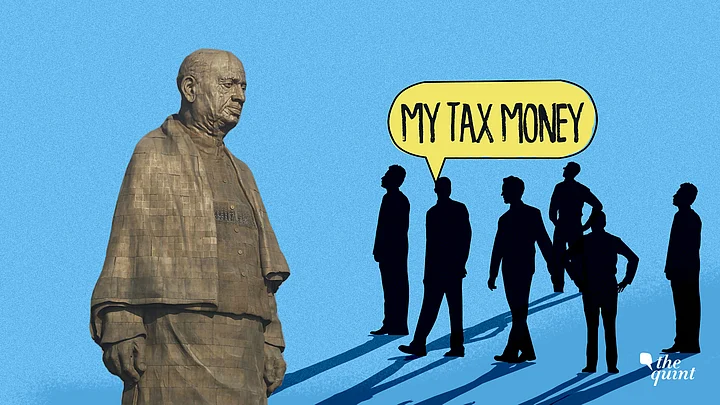(Disclaimer: This piece was originally published by the author on his personal blog, and a slightly altered version of this was published on The Quint, with the author's permission, on 31 October 2018. It is being republished again on 31 October 2021, on Sardar Patel’s birth anniversary.)
The Sardar Patel statue, also called ‘The Statue of Unity’, unveiled two years ago, is the biggest statue in the world at 182 metres tall. Built at the cost of about Rs 3,000 crore, it must be impressive to behold because of its sheer size.
It is supposed to represent the unity of the nation and be a tribute to a great man who united India.
Maybe that is so. But to me, it represents the power that those in government use to coerce people into doing their bidding. Certainly, it’s not the worst form of authoritarianism, like marching people off to the gulags – but it is something that reasonable leaders of a free people should never do. It is, in a way, a misuse of power.
To be clear, my argument is not about alternative uses that Rs 3,000 crore could have been put to.
That amount could have helped, for instance, 300,000 families climb out of extreme poverty. But that’s not the substance of my objection. You can always find alternative uses for any expenditure. It is then just a matter of differing opinions and preferences.
Was Funding For Statue Of Unity Obtained Through ‘Force’?
My objection is not about what the money was spent on. My objection is about how the money for the project was obtained. Regarding the financing of the project, a Times of India report says: “The government of Gujarat had allotted Rs 100 crore (1 billion) for the project in the budget for 2014-15 and Rs 75 crore in 2015-16. According to India Today, in the Union budget of 2014-15, Rs 200 crore was allocated.”
The fact is that the Government of Gujarat and and the Central Government partly financed the project. That means taxes collected from citizens were used.
In other words, a significant portion of the funding was obtained through coercion. To put it bluntly, it was taken on the threat of violence.
Just to be clear, taxes always involve the use or the threat of the use of force. The government dictates how much you owe in taxes; if you don’t pay, you are threatened with jail and/or the confiscation of your property; if you resist, you are restrained. The process may initially appear all very civilised and lawful but ultimately it is you (usually unarmed) against the (heavily-armed) government. You cannot win that contest.
The end – of building a humongous statue of a great man who is believed to have stood for freedom and justice – does not come close to justifying the means, the threat and use of force.
As is the norm in matters such as the building of pyramids, or the Taj Mahal and other impressive monuments to human vanity and the lust for power,
Modi will be celebrated as the person who built the Statue of Unity.
Truth is, he did not.
Ordinary Indians toiled to earn a living; part of that income was taken away, and was spent on Patel’s statue. Millions of extremely poor people paid unknowingly or unwillingly, out of their very meagre earnings, the money to build the statue. I don’t think Sardar Patel would have approved of this misuse of power.
Power & Persuasion
There are two distinct ways of getting people to do something: one is to persuade them somehow. If you succeed, people act willingly.
Persuasion leads to consensual behavior. It is the mark of a civilised society that people persuade each other and cooperate to attain mutually beneficial goals. This is most evident in free markets, where people persuade and cooperate, buy and sell. It’s an enterprise which involves no force because all transactions are voluntarily entered into.
The other way to get people to do your bidding is to use power. Bullies use power, not persuasion. Governments use power, not persuasion. Power is their only instrument. That’s why governments of civilised nations are constrained by the Constitution to a limited set of activities.
What Modi Could Have Said And Done
PM Narendra Modi, as an individual and a citizen, could have used persuasion to build the Sardar Patel statue. He could have said, for example: “Mitron, we have to honour a great son of India, Sardar Patel. Let’s build the world’s largest statue in his image. Let’s contribute whatever we can, according to our means, to this great project. Let’s show the world that we Indians are free people that don’t need to be forced to do the right thing. Let’s show the world that we are free people in a free country, a country that Sardar helped create. He built India. Let’s build a statue to honour him.”
Not just Indian citizens, I am sure that people around the world, who care about India, would have willingly contributed to that project. Instead, Modi as the prime minister decided that Indians will not willingly fund the statue.
People Have Lost Their Ability To Reason
That the government uses coercion to extract money to boost its image is par for the course. What’s really distressing is that the people of India find it acceptable and even praiseworthy. It shows that the people have lost their independence, their pride, their ability to reason, to make their own choices, to be their own masters.
Big statues are certain to impress, but ultimately, they don’t matter. The big picture is about the prosperity of the people, which depends to a great degree on good governance.
(Atanu Dey, PhD, is an economist. He tweets at @atanudey. This is an opinion piece and the views expressed are the author's own. The Quint neither endorses nor is responsible for them.)
